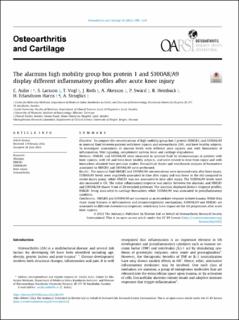| dc.contributor.author | Aulin, C. | |
| dc.contributor.author | Larsson, S. | |
| dc.contributor.author | Vogl, T. | |
| dc.contributor.author | Roth, J. | |
| dc.contributor.author | Åkesson, A. | |
| dc.contributor.author | Swärd, P. | |
| dc.contributor.author | Heinbäck, R. | |
| dc.contributor.author | Harris, Helena Erlandsson | |
| dc.contributor.author | Struglics, A. | |
| dc.date.accessioned | 2022-11-18T10:10:39Z | |
| dc.date.available | 2022-11-18T10:10:39Z | |
| dc.date.created | 2022-10-24T12:38:23Z | |
| dc.date.issued | 2022 | |
| dc.identifier.issn | 1063-4584 | |
| dc.identifier.uri | https://hdl.handle.net/11250/3032810 | |
| dc.description.abstract | Objective
To compare the concentrations of high mobility group box 1 protein (HMGB1) and S100A8/A9 in synovial fluid between patients with knee injuries and osteoarthritis (OA), and knee healthy subjects. To investigate associations of alarmin levels with different joint injuries and with biomarkers of inflammation, Wnt signaling, complement system, bone and cartilage degradation.
Methods
HMGB1 and S100A8/A9 were measured in synovial fluid by immunoassays in patients with knee injuries, with OA and from knee healthy subjects, and were related to time from injury and with biomarkers obtained from previous studies. Hierarchical cluster and enrichment analyses of biomarkers associated to HMGB1 and S100A8/A9 were performed.
Results
The synovial fluid HMGB1 and S100A8/A9 concentrations were increased early after knee injury; S100A8/A9 levels were negatively associated to time after injury and was lower in the old compared to recent injury group, while HMGB1 was not associated to time after injury. The S100A8/A9 levels were also increased in OA. The initial inflammatory response was similar between the alarmins, and HMGB1 and S100A8/A9 shared 9 out of 20 enriched pathways. The alarmins displayed distinct response profiles, HMGB1 being associated to cartilage biomarkers while S100A8/A9 was associated to proinflammatory cytokines.
Conclusions
HMGB1 and S100A8/A9 are increased as an immediate response to knee trauma. While they share many features in inflammatory and immunoregulatory mechanisms, S100A8/A9 and HMGB1 are associated to different downstream responses, which may have impact on the OA progression after acute knee injuries. | en_US |
| dc.language.iso | eng | en_US |
| dc.publisher | Elsevier | en_US |
| dc.rights | Navngivelse 4.0 Internasjonal | * |
| dc.rights | Navngivelse 4.0 Internasjonal | * |
| dc.rights.uri | http://creativecommons.org/licenses/by/4.0/deed.no | * |
| dc.title | The alarmins high mobility group box protein 1 and S100A8/A9 display different inflammatory profiles after acute knee injury | en_US |
| dc.type | Journal article | en_US |
| dc.type | Peer reviewed | en_US |
| dc.description.version | publishedVersion | en_US |
| dc.rights.holder | Copyright 2022 The Author(s) | en_US |
| cristin.ispublished | true | |
| cristin.fulltext | original | |
| cristin.qualitycode | 1 | |
| dc.identifier.doi | 10.1016/j.joca.2022.06.009 | |
| dc.identifier.cristin | 2064356 | |
| dc.source.journal | Osteoarthritis and Cartilage | en_US |
| dc.source.pagenumber | 1198-1209 | en_US |
| dc.identifier.citation | Osteoarthritis and Cartilage. 2022, 30 (9), 1198-1209. | en_US |
| dc.source.volume | 30 | en_US |
| dc.source.issue | 9 | en_US |

